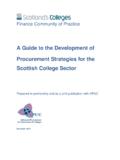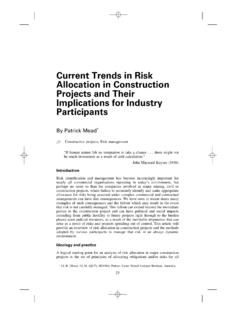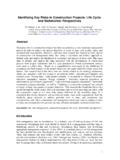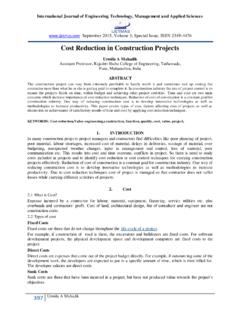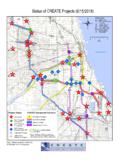Transcription of Guide to Construction Projects - APUC
1 Guide to Procuring Construction Projects 2 Contents 1. Introduction .. 3 2. The Construction project .. 4 Who s who? - The Client s Team .. 4 Who s who? - Externals .. 5 The Design Team .. 6 The 8 The project Procurement Strategy .. 8 Forms of Contract .. 12 Elements of the Construction project .. 15 The Design Team .. 17 Design Team Contract .. 18 Collateral Warranties .. 18 3. project management and 19 The Decision Point Process .. 19 The Programme .. 20 RIBA Plan of work: Key Stages in a Capital project .. 22 Health and Safety (CDM) .. 25 Risks and Risk Management .. 26 The Construction Phase .. 27 Occupation and Use .. 32 Funding, Budget and Controlling 34 Sustainability .. 37 4. General Public Procurement Thresholds and Principles .. 39 Procuring and appointing the Design Team .. 43 Procurement of the Main Contractor .. 48 Framework Agreements .. 52 3 1. Introduction This Guide has been developed to assist Scotland s Colleges with the process of procuring Capital Projects of all types and is intended for use by anyone involved in the procurement of a Capital project .
2 Construction procurement differs from procuring goods in that there can seldom be a direct acquisition of a building (unless it is a small prefabricated unit, for example a school classroom). New buildings are seldom standard and the refurbishment of existing buildings non standard. Procuring a new or extending or refurbishing an existing building cannot be directly compared to the procurement of goods which can be requisitioned, and are often 'off the shelf' and where an immediate choice can generally be made in terms of cost and quality. The Client's accommodation or property requirements need to be defined and then various options considered. This document sets out the stages of the Construction process and identifies the people and organisations who will be involved. It provides a useful checklist for the Client in regard to all the main stages in delivering a Capital project and is applicable equally to major or minor Construction Projects , new build or refurbishment schemes.
3 Capital Projects which have a value of 1M or more must be managed in line with the Scottish Funding Council s Capital Projects Decision Point Process and Payment of Capital Grant Guidance. This Guide should be read in conjunction with the advice published by the Scottish Funding Council on its website, which sets out the general recommendations for the management of higher and further education Capital Projects . 4 2. The Construction project Who s who? - The Client s Team The Client has multiple responsibilities, and it is normal to divide these amongst several individuals so that the appropriate management structure can be implemented and conflicts of interest avoided. A typical Client-side structure is as follows: The overarching Client responsibilities and roles are: Responsibility for making the decision to invest in the project (Investment Decision Maker IDM) Responsibility for the approval of the project and thereafter providing a sustained commitment to the project (may be the Director of Finance, Vice Principal or such).
4 Ownership of the project at High Level. (Senior Responsible Owner) Should be a Senior Manager in the institution that requires the project , typically Head of the Department. He/she will define the scope of the project , and be responsible to the IDM for project delivery. They will ensure that the appropriate in-house structure is in place to inform the project , oversees the Business Case and the project budget, ensure that a brief is developed that clearly reflects the Projects objectives, establish a reporting procedure, resolve issues, approve major changes to the project and appoints the project Sponsor. Providing the appropriate interface between the Client Team and the Supply Team ( project Sponsor) who usually with the assistance of the project Manager (PM), will act as the day to day representative of the Client. The project Sponsor (PS) is the Client s representative, who acts as a single focal point for the day to day management of the project .
5 (For small/ medium sized Projects , the PS may also act as the project Manager) The PS does not have to be a Construction expert if supported by a PM, who requires Construction experience. The Main roles of the PS are to have a full understanding of the project , and to be able to communicate this to the PM and Design Team. The PS will co-ordinate user input, assist with preparing the project brief, control changes and risk. Manage the project budget and programme, secure professional services as required, determine the procurement route, manage reporting arrangements and provide a focal point for all Client contact with the Supply Team. 5 Dependant on the size of the project , some of the above roles can be combined, however, only if the person combining the roles has the necessary experience and authority. It is not advisable for one person to take all three roles. NOTE: Further information on the roles and responsibilities of the Client Team can be found in the OGC s Achieving Excellence in Construction Procurement Guide , Guide 2: project Organisation, Roles & Responsibilities.
6 project Manager role-managing and co-coordinating the Design Team on a day to day basis (only where the institution does not employ a consultant PM). It is noted that the Cli ent body should only take on the duties of the PM, where there is a suitably qualified and experienced resource available in-house. project Roles should be allocated in such a way that everyone in the Clients team is committed to successful delivery of the project . Responsibilities should be given to those individuals who have the appropriate ability, resources and level of responsibility to carry out their roles effectively. Who s who? - Externals The project Manager Dependant on the size of the project and the availability of appropriate internal resources, the institution may decide to either appoint a PM from its own staff (possibly a member of their Estates Team) or to appoint an external consultant. Depending upon the scope of the project and the institutional resource and where Projects are resource intensive it may be appropriate to appoint two PMs, one being an external consultant and the other internal from the institutions estates department.
7 The appointment of the PM is normally made 6 before any of the Design Team is appointed. The PM will work with the institution to assist with the appointment of the rest of the Team. The PM acts on behalf of the Client to direct the Design Team and ensure that they have the appropriate information and understanding to effectively execute the project . The PM has an obligation to recognise and respect the professional codes of the other disciplines which make up the project Team. The PM s main responsibility is therefore to the Client (institution), acting as the interface between the Design Team and the Client. The PM will also provide assistance in managing all the other key actions required to deliver the project , from advising on forms of contract, procurement options, managing risk, monitoring and reporting on the works as they proceed on site, assisting with procurement and management of fit-out and making arrangements for removals. The PM can also assist the Client in appointing the rest of the Design Team and Guide the Client through the project .
8 An important part of the role is ensuring that a comprehensive project brief is prepared, which will include firm information regarding costs, specifications and timescale. A well-prepared brief will form the basis of all the subsequent project actions, Product Information, Tender Action, Construction works etc. The Scope of Works to be provided by the PM will depend on the size and complexity of the project . The Client s responsibility to the PM is to clearly define the scope of their appointment at the outset. Further information can be found in Appendix A project Managers Check List. The Design Team Architect The Architects responsibility is to interpret and develop the Clients brief during the various stages of the project . The Architect will define the Client s requirements, identifying constraints, advise in terms of feasibility studies and option appraisals, arrange site investigations, establish the preferred solution, advise on sustainability, manage health and safety issues, develop the design, prepare room data sheets, obtain Client sign off of the design at appropriate stages, advise on materials selection, provide space planning services, advise on furniture/equipment selection, prepare Construction drawings and specifications, etc and with due respect to the client s brief , prepare a design which meets all the clients requirements, including budget and timescale.
9 The Architect acts as the leader of the rest of the Design Team and co-ordinates their specialist input with their own. The Architect will prepare and lodge the Planning Application and Building Warrants in co-ordination with the rest of the Team. During the works on site, the Architect will assist the Clerk of Works in monitoring quality on site. At handover the Architect will assist in ensuring that the works are complete and that the clients needs have been met, and will continue their involvement through the Defects Liability period, and the final resolution of defects. After novation (in the case of a Design & Build Contract), the Architect will work for the contractor and will no longer be in the direct employment or control of the client. The Quantity Surveyor The Quantity Surveyors (QS) roles are primarily in connection with providing cost advice to the Client throughout all stages of the project . 7 During the pre-contract stage, the QS will assist the PM in providing advice on procurement routes for the main contractor, preparing the tender documentation, receiving and analysing tenders and preparing the tender report for the Cli ent and recommendations for approval.
10 The QS will prepare the contract documentation on behalf of the Client. Where the client has a procurement department it is essential the QS liaise with procurement throughout the procurement process. During the contract period the QS monitors the project spend, providing regular reports to the Client, and will receive monthly valuations from the Main Contractor and will check these, before authorising the Architect to approve payment in the form of an Architect s Certificate. The QS will also assist with negotiations with the Contractor if any variations (changes) occur during the project , which have a financial impact. Following completion of the Construction Works, the QS will liaise with the Contractor in agreeing the Final Account. It is normal for this to take up to 12 months after completion, but this could take longer if the project is complex and there were many variations during the project . Other responsibilities are: Life Cycle cost analysis.
